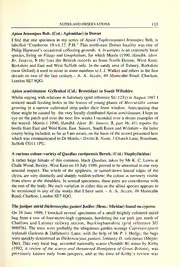
Apion brunnipes Boh. (Col.: Apionidae) in Dorset PDF
Preview Apion brunnipes Boh. (Col.: Apionidae) in Dorset
NOTESANDOBSERVATIONS 133 ApionbrunnipesBoh. (Col.: Apionidae) in Dorset I find that one specimen in my series ofApion (Taphrotopium) brunnipes Boh, is labelled "Cranborne 18.vii.37. P.H." This north-east Dorset locality was one of Philip Harwood's occasional collecting-grounds. A. brunnipes is an extremely local species, living on Filago and Gnaphalium, for which Morris (1990. Handbk. ident. Br. Insects, 5:16) lists the British records as from North Devon, West Kent, Berkshire and East and West Suffolk only. In the sandy area ofTubney, Berkshire (nearOxford) it usedto occur in some numbers to J. J. Walkerand others in the first decade or two of the last century.- A. A. Allen, 49 Montcalm Road, Charlton, London SE7 8QG. Apionsemivittatum Gyllenhal (Col.: Brentidae) in South Wiltshire Whilst staying withrelations in Salisbury (gridreference SU 1231) in August 1987 I noticed small feeding holes in the leaves of young plants of Mercurialis annua growing in a narrow cultivated strip under their front window. Anticipating that these might be caused by the very locally distributedApion semivittatum, I kept an eye on the patch and over the next few weeks I recorded over a dozen examples of the weevil. Morris ( 1990, Handbk. Ident. Br. Insects. 5, part 16: 41) reports the beetlefromEast andWest Kent, East Sussex, South Essex andWiltshire-the latter county being included, as faras I am aware, onthebasis ofthe recordpresented here whichwascommunicatedtoDrMorris.-DavidR. Nash, 3 ChurchLane, Brantham, SuffolkCO11 IPU. Acuriouscolour-varietyofQuediuscurtipennis Bernh. (Col.: Staphylinidae) A rather large female of this common, black Quedius, taken by Mr K. C. Lewis at ChalkWood, Bexley, WestKenton 10July 1989,provedtobe abnormal inone very unusual respect. The whole of the epipleurs, or turned-down lateral edges of the elytra, are very distinctly and sharply reddish-yellow; the colour is narrowly visible from above at the shoulders. In normal specimens, these parts are concolorous with the rest ofthe body. No such variation in either this or the allied species appears to be mentioned in any of the works that I have seen. - A. A. Allen, 49 Montcalm Road, Charlton, London SE7 8QG. ThejunipermiridDichrooscytusgustaviJosifov(Hem.: Miridae)foundoncypress On 24 June 1999, I knocked several specimens of a small brightly coloured mirid bug from a row of four-metre-high cypresses, bordering the car park just north of Chalfont and Latimer railway station, Buckinghamshire (grid reference SU 996976). The trees were probably the ubiquitous garden scourge Cupressocyparis leylandii (Jackson & Dallimore). Later, with the help of Mr P. J. Hodge, the bugs were quickly determined asDichrooscytus gustavi, formerly D. valesianus (Meyer- Diir). This very local bug, accorded nationally scarce (Notable B) status by Kirby (1992; A review ofthe scarce and threatened Hemiptera ofGreat Britain), was previously known only from junipers, and at the time of Kirby's review was
